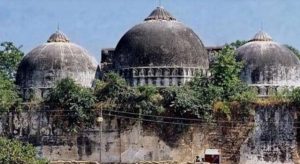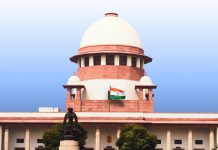 The unanimous verdict by the 5-judge Constitution bench headed by Chief Justice Ranjan Gogoi of the Supreme Court of India, is one of the most important and most anticipated judgments in India’s history, which has put an end to the more than a century old dispute that had torn the social fabric of the nation. The judgment has cleared the way for the construction of a Ram Temple at the disputed site at Ayodhya and has directed the Centre to allot a 5-acre plot at a “prominent site” to the Sunni Waqf Board for building a mosque.
The unanimous verdict by the 5-judge Constitution bench headed by Chief Justice Ranjan Gogoi of the Supreme Court of India, is one of the most important and most anticipated judgments in India’s history, which has put an end to the more than a century old dispute that had torn the social fabric of the nation. The judgment has cleared the way for the construction of a Ram Temple at the disputed site at Ayodhya and has directed the Centre to allot a 5-acre plot at a “prominent site” to the Sunni Waqf Board for building a mosque.
Conflict over Ayodhya has been raging between India’s Muslims and Hindus for more than 150 years. Muslims say it is a historical place of worship, but Hindus say the mosque, built by the Mughal emperor Babur, was on the site of an older temple honouring Ram’s birthplace.
The country was put on high security alert following the verdict for fear of religious violence and rioting. Thousands of police and paramilitary troops were dispatched to the state of Uttar Pradesh and around 500 people arrested in the days before. Protests and parties were also banned in Ayodhya.
The apex court has now directed that a trust should be formed within three months for the construction of the temple at the site many Hindus believe Lord Ram was born. The site was occupied by the 16th century Babri mosque, built by Mughal Empire’s founder Babur, which was destroyed by Hindu kar sevaks on December 6, 1992. Fourteen appeals were filed in the apex court against the 2010 Allahabad High Court judgment, delivered in four civil suits, that the 2.77-acre land in Ayodhya be partitioned equally among the three parties — the Sunni Waqf Board, the Nirmohi Akhara and Ram Lalla.
The bench said the existence of Sita Rasoi, Ram Chabutra and Bhandar grih are the testimony of the religious fact of the place. The apex court had on August 6 commenced day-to-day proceedings in the case as the mediation proceedings initiated to find the amicable resolution had failed. The bench on October 16 had reserved the judgment after a marathon hearing of 40 days.
Now when the historic judgment has arrived, we at Tehelka agree with all sane voices and the prime minister, Narendra Modi who has rightly said that the “Supreme Court verdict should not be seen as anybody’s win or loss”. He tweeted “Whether it is devotion to Ram or Rahim, now is time for everybody to strengthen devotion to India”.
Now that the lingering issue that polarized the country and frayed the tapestry of society has been resolved and decks cleared for the construction of a Ram Temple and land for building a mosque, the focus of the nation should shift to other important issues concerning development of the country, governance, better law and order, jobs and social and economic prosperity. Every stakeholder should pitch in to make goal of making India a $5trillion economy by 2025, a reality. Moto should now be achieving the much-avowed “Ram Rajya”.












